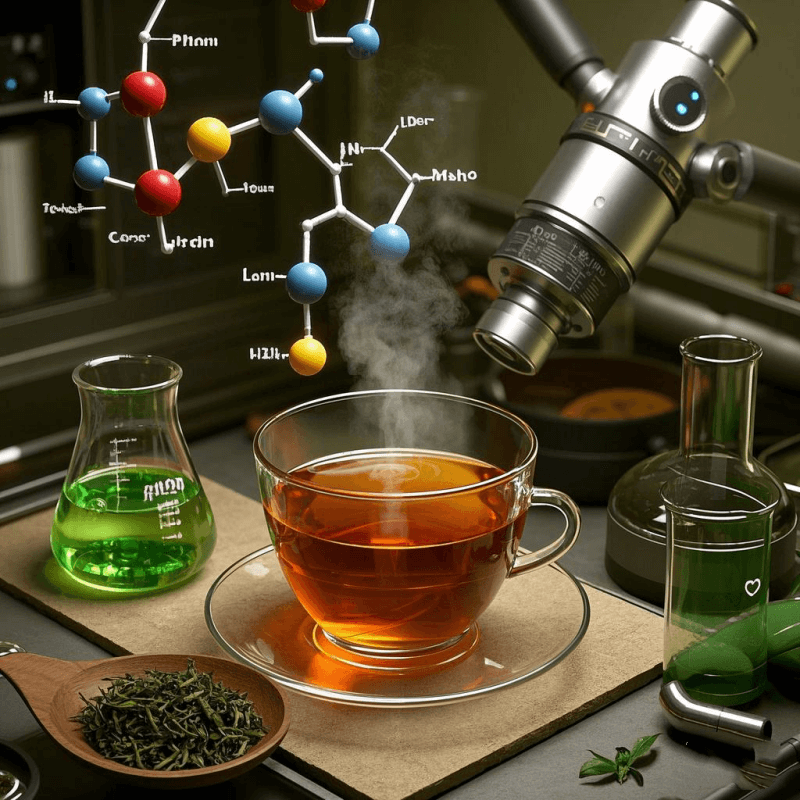Introduction

Oolong tea, a traditional partially-fermented tea from the Camellia sinensis plant, has gained significant attention among American health-conscious consumers seeking low-sugar alternatives to sodas and energy drinks. This distinctive tea offers a middle ground between green and black tea, providing sustained energy for busy workdays while delivering potential health benefits through cold brewing without the guilt of added sugars.
The health claims surrounding oolong tea are supported by varying levels of scientific evidence, ranging from population studies and randomized controlled trials to systematic reviews. While promising, it’s important to note that no single food or beverage can cure diseases, and individual results may vary based on overall diet and lifestyle patterns.
Ready to discover what science says about oolong tea? Jump to our Quick Answer for the key takeaways, or continue reading for the complete evidence-based breakdown.
Quick Answer
Key Evidence-Based Benefits of Oolong Tea:
• May support weight management – Catechins and polyphenols may boost metabolism and fat oxidation, though evidence comes primarily from short-term, small-sample studies
• Cardiometabolic markers – Observational studies suggest potential benefits for blood pressure and lipid profiles, but evidence quality varies and long-term effects need more research
• Stress management & alertness – Unique combination of moderate caffeine (25-50mg per cup) plus L-theanine provides calm alertness without jitters
• Anti-inflammatory & antioxidant potential – Rich in polyphenols that show promise in laboratory and animal studies, though human evidence is still developing
Takeaway: Oolong tea shows promise as a healthy beverage choice, but benefits are most evident when replacing high-sugar drinks as part of an overall healthy lifestyle.
What Is Oolong Tea?
Oolong tea originates from the Camellia sinensis plant and undergoes partial fermentation (oxidation), positioning it uniquely between green tea (unoxidized) and black tea (fully oxidized). Traditional processing involves withering, rolling, partial oxidation (20-80%), and firing, creating complex flavor profiles ranging from light and floral to rich and roasted.
Oolong vs. Green vs. Black Tea Comparison
| Aspect | Oolong Tea | Green Tea | Black Tea |
| Oxidation Level | 20-80% | <5% | 80-100% |
| Caffeine Content | 25-50mg/cup | 25-40mg/cup | 40-70mg/cup |
| Flavor Profile | Complex, fruity to roasted | Grassy, fresh | Bold, malty |
| Best Brewing Temp | 185-205°F | 160-180°F | 200-212°F |
| Ideal For | Afternoon focus, cold brewing | Sensitive caffeine users | Morning energy boost |
When to choose oolong: Perfect for those wanting more complex flavors than green tea but less caffeine intensity than black tea, especially for sustained afternoon energy or sophisticated cold-brew preparations.
Science-Backed Benefits
Weight Management & Fat Oxidation
Mechanism: Oolong tea’s catechins (particularly EGCG) and polyphenols may increase energy expenditure and enhance fat oxidation through thermogenesis activation. The partial fermentation process creates unique polymerized polyphenols not found in green or black tea.
Evidence Summary:
- Small RCTs: 6-week study (n=102) showed 6% greater fat loss in oolong group vs. control
- Short-term metabolic studies: 2-4 hour post-consumption increases in fat oxidation (10-17%)
- Limitations: Most studies under 12 weeks, small sample sizes, results may not translate to long-term weight loss
Takeaway: Oolong tea may provide modest metabolic support, but works best as a replacement for high-calorie beverages rather than a standalone weight loss solution.
Heart Health: Blood Pressure & Lipids
The Evidence: Large observational studies suggest regular tea consumption correlates with better cardiovascular health markers, though correlation doesn’t equal causation.
Key Findings:
- Population studies: Daily tea drinkers show 10-15% lower risk of heart disease
- Meta-analyses: Modest reductions in systolic blood pressure (2-3 mmHg) and LDL cholesterol
- Mechanisms: Polyphenols may improve endothelial function and reduce arterial stiffness
Important Note: Benefits appear strongest when tea replaces less healthy beverages and is part of an overall heart-healthy lifestyle including regular exercise and balanced nutrition.
Takeaway: Regular oolong consumption may support heart health as part of a comprehensive approach, but shouldn’t replace proven interventions like medication when needed.
Blood Sugar & Metabolic Flexibility
Current Evidence: Primarily based on animal studies and small human trials showing potential improvements in glucose metabolism and insulin sensitivity.
Research Highlights:
- Animal studies: Oolong extract improved glucose tolerance in diabetic mice
- Small human trials: Post-meal blood sugar spikes reduced by 15-20% in some studies
- Proposed mechanism: Polyphenols may slow carbohydrate absorption and improve insulin signaling
Practical Application: Most beneficial as a replacement for sugary drinks rather than a diabetes treatment. Always consult healthcare providers for blood sugar management.
Takeaway: Promising early evidence for metabolic support, but human studies are limited and results shouldn’t replace standard diabetes care.
Stress Management & Mental Alertness
The Science: Oolong’s unique combination of moderate caffeine (25-50mg per cup) plus L-theanine amino acid creates sustained alertness without the crash associated with higher-caffeine beverages.
Benefits:
- Sustained energy: Caffeine provides 3-4 hours of alertness
- Reduced jitters: L-theanine promotes calm focus
- Individual variation: Caffeine sensitivity varies greatly between people
Best Timing: Morning or early afternoon consumption; avoid within 6 hours of bedtime to prevent sleep disruption.
Takeaway: Ideal for those seeking steady energy and focus without the intensity of coffee or energy drinks.
Antioxidant & Anti-Inflammatory Potential
Polyphenol Power: Oolong contains unique theaflavins and thearubigins created during partial fermentation, plus catechins found in green tea.
Laboratory Evidence:

- Cell studies: Oolong extracts show strong free radical scavenging activity
- Animal research: Anti-inflammatory effects in various disease models
- Human translation: Limited direct evidence, but antioxidant activity measurable in blood after consumption
Important Context: While laboratory results are promising, real-world benefits depend on overall diet quality, lifestyle factors, and individual health status.
Takeaway: Oolong contributes valuable antioxidants to your daily intake, but works best as part of a diet rich in fruits, vegetables, and other whole foods.
Oolong vs. Green Tea: Which Should You Choose?
Choose Oolong If You Want:
- More complex, nuanced flavors (floral to roasted)
- Moderate caffeine levels for sustained energy
- Better performance in cold brewing applications
- A sophisticated alternative to flavored beverages
Choose Green Tea If You’re:
- Highly sensitive to caffeine
- Preferring lighter, grassier flavors
- Looking for the most studied tea variety
- New to tea drinking and want gentler introduction
Practical Comparison:
| Scenario | Best Choice | Why |
| Morning energy | Oolong | Balanced caffeine, complex flavor |
| Afternoon focus | Either | Personal preference for flavor |
| Cold brewing | Oolong | Superior flavor extraction when cold |
| Caffeine sensitivity | Green tea | Lower caffeine content |
| First-time tea drinker | Green tea | Milder, more familiar taste |
How Much, How to Brew (Hot & Cold)
Recommended Dosage & Frequency
Daily Amount: Start with 1-2 cups per day and adjust based on caffeine tolerance. Most studies showing benefits used 2-3 cups daily.
Special Considerations:
- Pregnant/breastfeeding: Limit to 1 cup daily due to caffeine content
- Taking medications: Consult healthcare provider about potential interactions
- Iron deficiency: Drink between meals rather than with iron-rich foods
Hot Brewing Method
Perfect Hot Oolong:
- Water temperature: 185-205°F (adjust based on oxidation level – lighter oolongs use cooler water)
- Tea amount: 1 teaspoon loose leaf or 1 tea bag per cup
- Steeping time: 3-5 minutes for first brew (high-quality oolongs can be re-steeped multiple times)
- Pro tip: Rinse loose leaves with hot water for 30 seconds, discard, then brew normally
Cold Brewing & Iced Oolong
American-Style Cold Brew (Perfect for unsweetened iced tea):
- Ratio: 1 tablespoon loose leaf per cup of cold water
- Time: Refrigerate 6-12 hours
- Strain: Remove leaves and serve over ice
- Storage: Keeps 3-4 days refrigerated
- Flavor boost: Add lemon slice or mint without sugar
Quick Iced Method: Brew hot using double the tea amount, then pour over ice immediately.
Safety & Who Should Avoid
General Safety Profile
Oolong tea is generally safe for healthy adults when consumed in moderation (2-4 cups daily).
Potential Side Effects & Precautions:
Caffeine-Related Effects:
- Insomnia, jitters, or rapid heartbeat in sensitive individuals
- Headaches if consumed excessively or if stopping abruptly
Iron Absorption: Tannins may reduce iron absorption from plant sources – drink between meals if you have iron deficiency.
Drug Interactions:
- Blood thinners: May enhance effects
- Stimulant medications: Could increase side effects
- Iron supplements: Separate consumption by 2+ hours
Who Should Consult Healthcare Providers First:
- Individuals with heart conditions, anxiety disorders, or sleep issues
- People taking prescription medications
- Those with iron deficiency anemia
- Pregnant or breastfeeding women
Smart Shopping Guide (US Market)
Quality Indicators
Look For:
- Whole leaf or semi-rolled pellets over tea bags for better flavor
- Origin information: Taiwan, Fujian, or other specific regions
- Harvest date: Fresher is better (within 2 years)
- Roasting level: Light for floral notes, medium-dark for richer flavors
Ready-to-Drink Options
RTD Oolong Shopping:
- Check labels: Look for “unsweetened” or “lightly sweetened” options
- Caffeine content: Should be clearly labeled (varies widely)
- Ingredients list: Avoid artificial flavors and excessive preservatives
- Refrigeration: Choose refrigerated over shelf-stable when possible
Budget & Availability
Price Points:
- Budget-friendly: Tea bags and basic loose leaf ($0.10-0.30 per cup)
- Premium: High-grade Taiwanese or Chinese oolongs ($0.50-2.00+ per cup)
- Sweet spot: Mid-range loose leaf offers best value for daily drinking
Market Context: With matcha prices rising due to supply constraints, oolong presents an accessible alternative for those seeking sophisticated tea experiences without premium pricing.
Frequently Asked Questions
Does oolong tea help with weight loss?
Current evidence suggests oolong may provide modest metabolic support through increased fat oxidation, but effects are small and studies are short-term. The most realistic benefit comes from using unsweetened oolong to replace high-calorie beverages like sodas, specialty coffee drinks, or sweet teas. A 12-oz soda contains ~150 calories and 39g sugar, while unsweetened oolong has virtually zero calories.
Bottom line: Oolong supports weight management best as part of a calorie-controlled diet, not as a standalone solution.
How much caffeine is in oolong tea?
Oolong typically contains 25-50mg of caffeine per 8-oz cup, compared to coffee’s 95mg. However, caffeine content varies significantly based on:
- Processing method: More oxidized oolongs tend to have higher caffeine
- Brewing strength: Longer steeping increases caffeine extraction
- Leaf quality: Higher grades often contain more caffeine
For sensitive individuals: Start with lightly oxidized oolongs and shorter steeping times, or choose green tea instead.
Is oolong tea good for heart health?
Large population studies show regular tea drinkers have lower rates of heart disease, but these are observational studies that can’t prove causation. The evidence suggests potential benefits for blood pressure and cholesterol levels, likely due to polyphenol content and the displacement of less healthy beverages.
Key limitation: Most research doesn’t isolate oolong specifically from other tea types, so green and black tea may provide similar cardiovascular benefits.
What’s the best time to drink oolong tea?
Optimal timing:
- Morning: Provides gentle energy boost without coffee’s intensity
- Mid-afternoon: Sustained energy for the 2-3 PM energy dip
- Pre-workout: Low-calorie alternative to sports drinks (consume 30-60 minutes before exercise)
- Avoid: Within 6 hours of bedtime due to caffeine content
With meals: Drink between meals rather than with iron-rich foods to avoid potential iron absorption interference.
